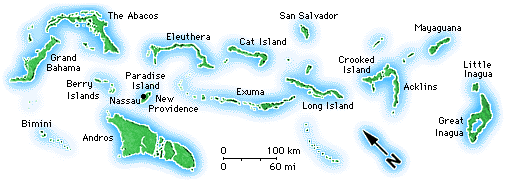Amerindians History
The Lucayans(Bahamain Islands) by: George A. Aarons.
When Columbus, the great admiral and navigator, arrived at San Salvador in the Bahamas on October 12, 1492, he found there a group of people known to us as the Lucayans. It was at this juncture that the 15th century inhabitants of the Bahamas entered written history. But their history, as can today be pieced together through archaeological, anthropological, ethnographical and historical research, actually predates this momentous event by many centuries.

It is believed that the ancestors of all (or at least the overwhelming majority) of the people present in the Western Hemisphere on that epic day almost five centuries ago, crossed over the then solid Bering Straits.
They moved between what is now Siberia and Alaska during a particularly cold period some 40-60,000 years ago. By 20,000 years ago they had spread throughout the contiguous continents of North and South America, and by 5,000 B.C., their descendants had penetrated into some of the islands of the Caribbean Sea.
By 500 B.C., waves of migration of an Arawakan-speaking people, whose ancestral home had been the great river basins of northern South America, began to venture out into the Caribbean Sea, threading through the islands of the Eastern Caribbean.
Two hundred years later, these Taino peoples, commonly today called Arawaks, had colonized Puerto Rico and by A.D. 500, had probably settled in all of the Greater Antilles, supplanting, in at least some of these islands, the vestiges of the descendants of older migrants.
By 600 A.D., probably because of the joint impulses of population pressure and trade, the Taino from Hispaniola began to colonize the islands to the north--the Bahamas.
Probably com-mencing with Great Inagua, by A.D. 1492, they had settled at least all the major islands of the Bahamian archipelago, by which time they had evolved a culture both similar and dissimilar in some respects to their Taino relatives in the Greater Antilles to the south.
These were the first Bahamians--the Lucayans--who at the end of October, 1492 guided Columbus through their archi- pelago, well known to them through trade and food resource exploitation, to the Greater Antilles to the south, with whose inhabitants they maintained trade and other relations.
At least 50,000 strong in 1492, within a century they would suffer nearly complete annihilation. Today there is no one living who can truly claim to have Lucayan ancestry.
The horrible death toll can be accounted for by the presence of the early Spanish and other Old World colonists, who carried many of the Lucayans from the archipelago to Hispaniola and Cuba in chains, and unconsciously passed on diseases to the Lucayans, who had little or no immunity, with fatal consequences.
A culture and a pattern of life had forever been destroyed. Like all the Tainos of the Caribbean, the Lucayans were governed by hereditary caciques (chiefs) who had both temporal and religious duties. Each cacique was responsible for a specific area, and each island probably had more than one caciquedom.
The Lucayans, who exploited both land and sea for their food, lived in villages in the Bahamas, in close proximity to the sea. The population of villages varied in number from a few individuals to many hundreds.
The homes of the ordinary families, the caneyes, were roughly circular made from thatch and wooden posts with a high cone-like roof, no windows and one door, large enough to accom-modate a nuclear family that spent most of the time outdoors.
The houses of the caciques (the bohios) were generally larger and rectangular and would be associated spatially with community facilities, which might take the form of a ball court for playing batos (a type of jai-alai) or a ceremonial plaza. The Lucayan bed was a hammock (hamaca), and the floors of their houses were of a beaten flattened clay.
Continue Skip Nav
Skip Nav